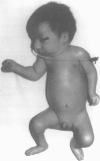Abstract
We report on a male patient born to healthy, first cousin, Moroccan parents. During the pregnancy growth retardation was observed. Birth weight, length, and OFC were all well below the 3rd centile. Facial anomalies, microphthalmia, cleft palate, small penis, and flexion contractures of large joints were noted. Cerebral MRI showed dysmyelination. The clinical course was characterised by feeding difficulties, growth failure, lack of development, photosensitivity, and death at 7 months. The main differential diagnoses were COFS syndrome and early onset Cockayne syndrome (CS). UV exposure of cultured fibroblasts showed inhibition of nucleic acids synthesis. Further DNA repair studies showed extreme cellular sensitivity to UV and xeroderma pigmentosum (XP)-like defective nucleotide excision repair (NER), which in combination with the clinical symptoms indicated the very rare XP-CS complex. Complementation analysis showed that the XPG gene is affected in this patient. In cases suspected of having COFS syndrome and early onset CS, extensive DNA repair studies are needed to reach the definitive diagnosis, thereby allowing reliable genetic counselling and prenatal diagnosis.
Full text
PDF



Images in this article
Selected References
These references are in PubMed. This may not be the complete list of references from this article.
- Bootsma D., Weeda G., Vermeulen W., van Vuuren H., Troelstra C., van der Spek P., Hoeijmakers J. Nucleotide excision repair syndromes: molecular basis and clinical symptoms. Philos Trans R Soc Lond B Biol Sci. 1995 Jan 30;347(1319):75–81. doi: 10.1098/rstb.1995.0012. [DOI] [PubMed] [Google Scholar]
- Broughton B. C., Thompson A. F., Harcourt S. A., Vermeulen W., Hoeijmakers J. H., Botta E., Stefanini M., King M. D., Weber C. A., Cole J. Molecular and cellular analysis of the DNA repair defect in a patient in xeroderma pigmentosum complementation group D who has the clinical features of xeroderma pigmentosum and Cockayne syndrome. Am J Hum Genet. 1995 Jan;56(1):167–174. [PMC free article] [PubMed] [Google Scholar]
- Jaeken J., Klocker H., Schwaiger H., Bellmann R., Hirsch-Kauffmann M., Schweiger M. Clinical and biochemical studies in three patients with severe early infantile Cockayne syndrome. Hum Genet. 1989 Nov;83(4):339–346. doi: 10.1007/BF00291378. [DOI] [PubMed] [Google Scholar]
- Lowry R. B. Early onset of Cockayne syndrome. Am J Med Genet. 1982 Oct;13(2):209–210. doi: 10.1002/ajmg.1320130211. [DOI] [PubMed] [Google Scholar]
- Lowry R. B., MacLean R., McLean D. M., Tischler B. Cataracts, microcephaly, kyphosis, and limited joint movement in two siblings: a new syndrome. J Pediatr. 1971 Aug;79(2):282–284. doi: 10.1016/s0022-3476(71)80114-2. [DOI] [PubMed] [Google Scholar]
- Nouspikel T., Clarkson S. G. Mutations that disable the DNA repair gene XPG in a xeroderma pigmentosum group G patient. Hum Mol Genet. 1994 Jun;3(6):963–967. doi: 10.1093/hmg/3.6.963. [DOI] [PubMed] [Google Scholar]
- O'Donovan A., Davies A. A., Moggs J. G., West S. C., Wood R. D. XPG endonuclease makes the 3' incision in human DNA nucleotide excision repair. Nature. 1994 Sep 29;371(6496):432–435. doi: 10.1038/371432a0. [DOI] [PubMed] [Google Scholar]
- Patton M. A., Giannelli F., Francis A. J., Baraitser M., Harding B., Williams A. J. Early onset Cockayne's syndrome: case reports with neuropathological and fibroblast studies. J Med Genet. 1989 Mar;26(3):154–159. doi: 10.1136/jmg.26.3.154. [DOI] [PMC free article] [PubMed] [Google Scholar]
- Pena S. D., Evans J., Hunter A. G. COFS syndrome revisited. Birth Defects Orig Artic Ser. 1978;14(6B):205–213. [PubMed] [Google Scholar]
- Robbins J. H., Kraemer K. H., Lutzner M. A., Festoff B. W., Coon H. G. Xeroderma pigmentosum. An inherited diseases with sun sensitivity, multiple cutaneous neoplasms, and abnormal DNA repair. Ann Intern Med. 1974 Feb;80(2):221–248. doi: 10.7326/0003-4819-80-2-221. [DOI] [PubMed] [Google Scholar]
- Robbins J. H. Xeroderma pigmentosum. Defective DNA repair causes skin cancer and neurodegeneration. JAMA. 1988 Jul 15;260(3):384–388. doi: 10.1001/jama.260.3.384. [DOI] [PubMed] [Google Scholar]
- Scott R. J., Itin P., Kleijer W. J., Kolb K., Arlett C., Muller H. Xeroderma pigmentosum-Cockayne syndrome complex in two patients: absence of skin tumors despite severe deficiency of DNA excision repair. J Am Acad Dermatol. 1993 Nov;29(5 Pt 2):883–889. doi: 10.1016/0190-9622(93)70263-s. [DOI] [PubMed] [Google Scholar]
- Sugarman G. I. Syndrome of microcephaly, cataracts, kyphosis, and joint contractures versus Cockayne's syndrome. J Pediatr. 1973 Feb;82(2):351–352. doi: 10.1016/s0022-3476(73)80198-2. [DOI] [PubMed] [Google Scholar]
- Vermeulen W., Jaeken J., Jaspers N. G., Bootsma D., Hoeijmakers J. H. Xeroderma pigmentosum complementation group G associated with Cockayne syndrome. Am J Hum Genet. 1993 Jul;53(1):185–192. [PMC free article] [PubMed] [Google Scholar]
- Vermeulen W., Scott R. J., Rodgers S., Müller H. J., Cole J., Arlett C. F., Kleijer W. J., Bootsma D., Hoeijmakers J. H., Weeda G. Clinical heterogeneity within xeroderma pigmentosum associated with mutations in the DNA repair and transcription gene ERCC3. Am J Hum Genet. 1994 Feb;54(2):191–200. [PMC free article] [PubMed] [Google Scholar]
- Winter R. M., Donnai D., Crawfurd M. D. Syndromes of microcephaly, microphthalmia, cataracts, and joint contractures. J Med Genet. 1981 Apr;18(2):129–133. doi: 10.1136/jmg.18.2.129. [DOI] [PMC free article] [PubMed] [Google Scholar]



